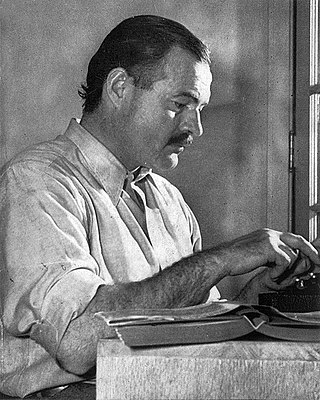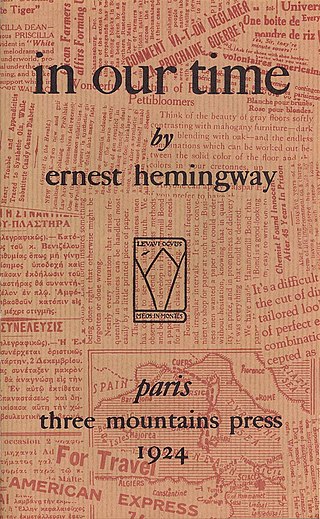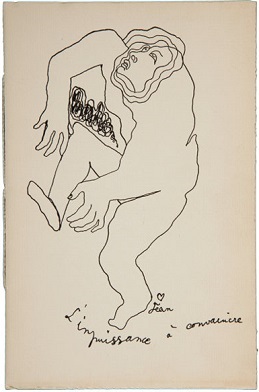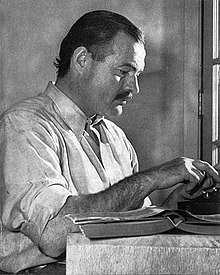
Ernest Miller Hemingway was an American novelist, short-story writer, and journalist. His economical and understated style—which included his iceberg theory—had a strong influence on 20th-century fiction, while his adventurous lifestyle and public image brought him admiration from later generations. Hemingway produced most of his work between the mid-1920s and the mid-1950s, and he was awarded the 1954 Nobel Prize in Literature. He published seven novels, six short-story collections, and two nonfiction works. Three of his novels, four short-story collections, and three nonfiction works were published posthumously. Many of his works are considered classics of American literature.

The Sun Also Rises is the first novel by the American writer Ernest Hemingway. It portrays American and British expatriates who travel along the Camino de Santiago from Paris to the Festival of San Fermín in Pamplona and watch the running of the bulls and the bullfights. An early modernist novel, it received mixed reviews upon publication. Hemingway biographer Jeffrey Meyers writes that it is now "recognized as Hemingway's greatest work" and Hemingway scholar Linda Wagner-Martin calls it his most important novel. The novel was published in the United States in October 1926 by Scribner's. A year later, Jonathan Cape published the novel in London under the title Fiesta. It remains in print.

The Torrents of Spring is a novella written by Ernest Hemingway, published in 1926. Subtitled "A Romantic Novel in Honor of the Passing of a Great Race", Hemingway used the work as a spoof of the world of writers. It is Hemingway's first long work and was written as a parody of Sherwood Anderson's Dark Laughter.

In Our Time is the title of Ernest Hemingway's first collection of short stories, published in 1925 by Boni & Liveright, New York, and of a collection of vignettes published in 1924 in France titled in our time. Its title is derived from the English Book of Common Prayer, "Give peace in our time, O Lord".

True at First Light is a book by American novelist Ernest Hemingway about his 1953–54 East African safari with his fourth wife Mary, released posthumously in his centennial year in 1999. The book received mostly negative or lukewarm reviews from the popular press and sparked a literary controversy regarding how, and whether, an author's work should be reworked and published after his death. Unlike critics in the popular press, Hemingway scholars generally consider True at First Light to be complex and a worthy addition to his canon of later fiction.

Across the River and Into the Trees is a novel by American writer Ernest Hemingway, published by Charles Scribner's Sons in 1950, after first being serialized in Cosmopolitan magazine earlier that year. The title is derived from the last words of U.S. Civil War Confederate General Thomas J. "Stonewall" Jackson: “Let us cross over the river and rest under the shade of the trees.”

"Soldier's Home" is a short story by Ernest Hemingway. It was included in the 1925 Contact Collection of Contemporary Writers and published by Boni & Liveright in Hemingway's 1925 New York collection short stories, In Our Time.

Winner Take Nothing is a 1933 collection of short stories by Ernest Hemingway. Hemingway's third and final collection of stories, it was published four years after A Farewell to Arms (1929), and a year after his non-fiction book about bullfighting, Death in the Afternoon (1932).
Show, don't tell is a narrative technique used in various kinds of texts to allow the reader to experience the story through actions, words, subtext, thoughts, senses, and feelings rather than through the author's exposition, summarization, and description. It avoids adjectives describing the author's analysis and instead describes the scene in such a way that readers can draw their own conclusions. The technique applies equally to nonfiction and all forms of fiction, literature including haiku and Imagist poetry in particular, speech, movie making, and playwriting.

"Big Two-Hearted River" is a two-part short story written by American author Ernest Hemingway, published in the 1925 Boni & Liveright edition of In Our Time, the first American volume of Hemingway's short stories. It features a single protagonist, Hemingway's recurrent autobiographical character Nick Adams, whose speaking voice is heard just three times. The story explores the destructive qualities of war which is countered by the healing and regenerative powers of nature. When it was published, critics praised Hemingway's sparse writing style and it became an important work in his canon.

"Cat in the Rain" is a short story by American author Ernest Hemingway (1899-1961), first published by Richard Hadley of Boni & Liveright in 1925 in the short story collection In Our Time. The story is about an American man and wife on vacation in Italy. Critical attention focuses chiefly on its autobiographical elements and on Hemingway's "theory of omission".
Ellipsis is the narrative device of omitting a portion of the sequence of events, allowing the reader to fill in the narrative gaps. Aside from its literary use, the ellipsis has a counterpart in film production. It is there to suggest an action by simply showing what happens before and after what is observed. The vast majority of films use ellipses to clear actions that add nothing to the narrative. Beyond these "convenience" ellipses, ellipses are also used to advance the story.

"Indian Camp" is a short story written by Ernest Hemingway. The story was first published in 1924 in Ford Madox Ford's literary magazine Transatlantic Review in Paris and republished by Boni & Liveright in Hemingway's first American volume of short stories In Our Time in 1925. Hemingway's semi-autobiographical character Nick Adams—a child in this story—makes his first appearance in "Indian Camp", told from his point of view.

"The Doctor and the Doctor's Wife" is a short story by Ernest Hemingway, published in the 1925 New York edition of In Our Time, by Boni & Liveright. The story is the second in the collection to feature Nick Adams, Hemingway's autobiographical alter ego. "The Doctor and the Doctor's Wife" follows "Indian Camp" in the collection, includes elements of the same style and themes, yet is written in counterpoint to the first story.

"Cross Country Snow" is a short story written by Ernest Hemingway. The story was first published in 1924 in Ford Madox Ford's literary magazine Transatlantic Review in Paris and republished by Boni & Liveright in Hemingway's first American volume of short stories In Our Time in 1925. The story features Hemingway's recurrent autobiographical character Nick Adams and explores the regenerative powers of nature and the joy of skiing.
On Writing is a story fragment written by Ernest Hemingway which he omitted from the end of his short story, "Big Two-Hearted River", when it was published in 1925 in In Our Time. It was then published after Hemingway's death in the 1972 collection The Nick Adams Stories.

"The Revolutionist" is an Ernest Hemingway short story published in his first American volume of stories In Our Time. Originally written as a vignette for his earlier Paris edition of the collection, titled in our time, he rewrote and expanded the piece for the 1925 American edition published by Boni & Liveright. It is only one of two vignettes rewritten as short stories for the American edition.

"My Old Man" is a short story written by Ernest Hemingway, published in his 1923 book Three Stories and Ten Poems, which published by a small Paris imprint. The story was also included in his next collection of stories, In Our Time, published in New York in 1925 by Boni & Liveright. The story tells of a boy named Joe whose father is a steeplechase jockey, and is narrated from Joe's point-of-view.

"Out of Season" is a short story written by Ernest Hemingway, first published in 1923 in Paris in the privately printed book, Three Stories and Ten Poems. It was included in his next collection of stories, In Our Time, published in New York in 1925 by Boni & Liveright. Set in Cortina d'Ampezzo, Italy, the story is about an expatriate American husband and wife who spend the day fishing, with a local guide. Critical attention focuses chiefly on its autobiographical elements and on Hemingway's claim that it was his first attempt at using the "theory of omission".

Today is Friday is a short, one act play by Ernest Hemingway. The play was first published in pamphlet form in 1926 but became more widely known through its subsequent publication in Hemingway's 1927 short story collection, Men Without Women. The play is a representation of the aftermath of the crucifixion of Jesus, in the form of a conversation between three Roman Soldiers and a Hebrew bartender. It is one of the few dramatic works written by Hemingway.











